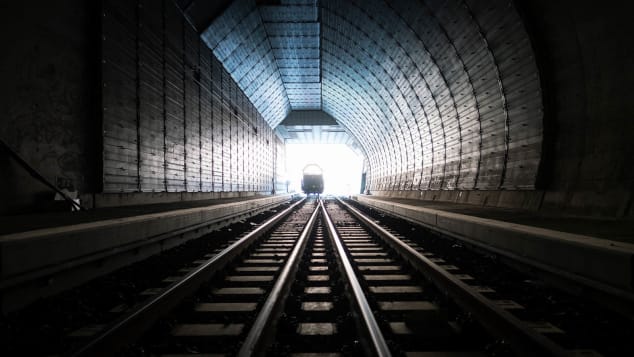Thousands of feet under the Swiss Alps, a new high-speed, high-capacity railway is close to completion. At its heart is the world’s longest railway tunnel — the 35-mile-long (or 57-kilometre) Gotthard Base Tunnel.
Everything about this $11.3 billion project is on a grand scale; at their deepest point, the GBT’s twin tunnels are around 8,000 feet below the Alpine peaks.
More than 2,500 people worked on its construction, carving and blasting their way through almost 30 million tonnes of granite before laying almost 250 miles of steel rails and installing thousands of miles of cables for power, signalling and communications systems.
With cross passages between the main tunnels every 1,066 feet, access tunnels and shafts the total length of the tunnel system is more than 95 miles.
Excavation of the two 35-mile running tunnels was completed in 2011 and employed a combination of traditional drilling/blasting and massive tunnel boring machines with 32-foot diameter cutting faces and miles of conveyor belts to carry rock away for recycling.
Excavation on this scale generated extraordinary quantities of rock and spoil; the rock from the Gotthard tunnels alone would have filled a train of wagons stretching from Zurich to Chicago — a distance of 4,440 miles.
A further eight million tonnes has been excavated from the new Ceneri Base Tunnel further south. Deep within the tunnels, two cavernous “multi-function stations” at Sedrun and Faido allow trains to cross between the two tunnels while maintenance is taking place or in case of emergencies.
Sedrun was intended to become by far the world’s deepest underground passenger station, known as Porta Alpina, with 2,600-foot-deep elevator shafts linking the platforms to the villages above, but the plan was dropped as uneconomic in 2012.
However, the GBT, which opened in 2016, is only part of the story. First proposed as far back as 1947, a new “flat” route through the Alps was backed by a Swiss national referendum in 1992 and test drilling started a year later.
In 2020, the final piece of the jigsaw — the shorter, but equally important Ceneri Base Tunnel, near Lugano, will finally see its first trains. This 9.5-mile-long tunnel eliminates the remaining “mountain” section of the busiest north-south route between the economic powerhouses of northern Europe and northern Italy.






